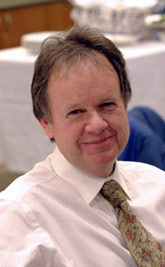
Handy Links
SLAC News Center
SLAC Today
- Subscribe
- Archives: Feb 2006-May 20, 2011
- Archives: May 23, 2011 and later
- Submit Feedback or Story Ideas
- About SLAC Today
SLAC News
Lab News
- Interactions
- Lightsources.org
- ILC NewsLine
- Int'l Science Grid This Week
- Fermilab Today
- Berkeley Lab News
- @brookhaven TODAY
- DOE Pulse
- CERN Courier
- DESY inForm
- US / LHC
SLAC Links
- Emergency
- Safety
- Policy Repository
- Site Entry Form

- Site Maps
- M & O Review
- Computing Status & Calendar
- SLAC Colloquium
- SLACspeak
- SLACspace
- SLAC Logo
- Café Menu
- Flea Market
- Web E-mail
- Marguerite Shuttle
- Discount Commuter Passes
-
Award Reporting Form
- SPIRES
- SciDoc
- Activity Groups
- Library
Stanford
Around the Bay
From the SLAC CRO

So just what is a "CRO"? In the corporate world, CRO can have many meanings—Chief Risk Officer, Chief Restructuring Officer, Chief Revenue Officer and Chief Research Officer among them. It is this latter definition that fortunately for me defines the role of a CRO at SLAC and typically at the other Department of Energy national laboratories. I was appointed SLAC's Chief Research Officer by SLAC Director Persis Drell in September and it is a real privilege and opportunity for me to serve in this capacity (in addition to my continuing role as SLAC Associate Laboratory Director for Photon Science).
In this brief article, I want to talk about the nature of this new job, both in the context of SLAC and in the broader DOE National Laboratory system.
The CRO is another of the O's that are a central element of the laboratory's management structure. Under the leadership of Persis (who has a role analogous to a Chief Executive Officer in the corporate sense), SLAC's Chief Operating Officer Sandy Merola, Chief Financial Officer Susan Calandra, Chief Information Officer Don Lemma, Chief Safety Officer Craig Ferguson and the Chief Research Officer (myself) have roles and responsibilities that support, coordinate and represent important activities cutting across many areas of the laboratory.
At SLAC, some of my own specific roles and responsibilities as CRO include coordination with the lab director and COO on topics of mutual concern that relate to SLAC's research agenda. I am also responsible for coordinating the science and technology component of the Annual DOE Laboratory Plan and for the annual PEMP science and technology goals. Another area of responsibility is in coordinating the development of international agreements and Memoranda of Understanding in scientific areas relevant to the lab's mission. I will also coordinate the annual Laboratory Directed Research and Development process, interfacing with others who expertly manage aspects such as the external peer review.
In broader DOE context, the O's come together as groups to more broadly engage in discussions and actions that reflect the needs of the DOE system of laboratories, seeking opportunities to address issues of common concern and offer advice. In the case of the CROs, there is a twice yearly face-to-face meeting and a monthly telecom where all CROs from all 17 of DOE's national laboratories participate. A principal role of the national CRO group is to help develop and support the agenda of the National Laboratory Director's Council, which is constituted of all of DOE laboratory directors. As the DOE National Laboratory system spans from the more basic science oriented laboratories (those primarily stewarded by the DOE Office of Science) to those with a more applied focus (e.g., the National Nuclear Security Administration labs), there are real opportunities to share experiences and coordinate on topics of common interest.
Such coordination is illustrated by some of the topics taken up by the National CRO group during the past year. A white paper was written to inform DOE management on the strength and opportunities of the laboratory system to contribute to DOE's energy mission. The CRO group was strongly engaged in helping define the DOE order on handling of nanomaterials and the safety aspects of such work. Most recently, the CRO group has engaged in helping DOE revise and streamline the DOE order that deals with foreign visits and assignments. These types of activities cut across both mission and mission support, so Sandy Merola and I make every effort to stay abreast and coordinate between the activities of the CRO and COO groups.
Returning to SLAC, it has been an absolutely remarkable year for our science. The great success of the Linac Coherent Light Source turn-on and the science productivity of the Fermi Gamma-ray Space Telescope demonstrate our ability and capabilities to deliver cutting edge, large scale projects with huge potential for innovation. Coupled with our other science programs and institutes, we are positioned to be at the forefront of our chosen fields for years to come. The Operations and Accelerator Directorates are increasingly well organized and structured to support this agenda. I look forward in my role as CRO to contributing to our realization of these opportunities.
